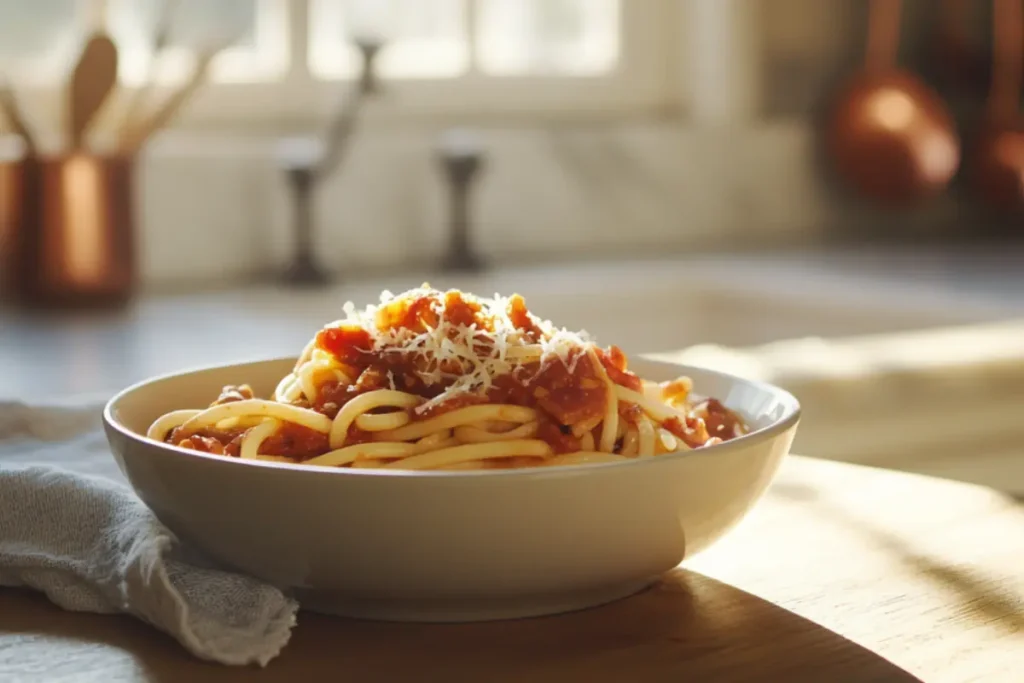Hi there! If you’ve ever twirled a forkful of pasta and wondered, “Am I doing this the Italian way?”—you’re not alone. So today we’re answering exactly that: How do Italians eat bucatini?
This delightfully thick noodle with a hole through the center is beloved across Italy—but it’s not your average pasta. There is a little Italian finesse involved when it comes to preparing, serving, and enjoying it the traditional way.
Whether you’re planning a cozy dinner at home or just curious about eating like a Roman, we’re diving into all the tasty details so you can bring a little slice of Italy to your table.
What Is Bucatini—and Why Does It Matter How It’s Eaten?
Bucatini (pronounced boo-kah-TEE-nee) is long like spaghetti but slightly thicker and hollow. That central tunnel allows sauces—especially rich, velvety ones—to sneak inside and coat every bite from the inside out. It’s hearty, satisfying, and has a bit more chew than your everyday noodle.
In Italian culture, pasta isn’t just a meal—it’s tradition, love, and connection. And yes, even the way you enjoy this shape is part of that ritual.
Traditional Italian Ways to Eat It
Pairing It with the Right Sauce

In Italy, this pasta is often paired with bold, savory sauces—especially ones that cling to the outside and seep into the hollow center.
Here are a few of the most iconic:
- All’Amatriciana: A Roman classic made with guanciale (cured pork cheek), Pecorino Romano, crushed tomatoes, and a touch of chili.
- Alla Gricia: A minimalist dish with just guanciale, Pecorino Romano, and black pepper.
- Cacio e Pepe: A creamy blend of cheese and black pepper, sometimes served with thicker pasta like this one.
Tip from Stacey: Keep the sauce balanced. In Italy, it’s all about harmony—neither the noodles nor the sauce should overpower the other.
How Italians Eat Bucatini at the Table

While table etiquette varies, there are a few universal guidelines Italians tend to follow:
- Use just a fork—no knife is needed.
- Twirl small amounts against the plate (or a spoon if you’re still learning).
- Try not to slurp. The noodle’s shape makes it a bit bouncy, but clean bites are preferred.
Take your time. Eating pasta in Italy is never rushed—it’s about savoring.
Traditional Pairings
Meals in Italy are often simple but thoughtfully composed. This pasta shape is commonly served with a glass of hearty red wine like Chianti or Montepulciano, a green salad, and rustic bread.
And of course, a strong espresso to finish the meal.
A Little Bucatini Memory from Stacey
Years ago on a rainy spring trip to Rome, I ducked into a tiny trattoria and ordered “whatever the chef recommends.” Out came a steaming bowl of all’Amatriciana—my first time trying this style of noodle. I’ll never forget how the sauce clung to every strand or how the guanciale melted into crispy little gems. I left with tomato on my chin and a full heart. That dish? Completely unforgettable.
FAQ: More About Bucatini
What is a good substitute for bucatini?
If you can’t find this pasta at your local market, don’t worry—there are several great alternatives:
- Thick spaghetti (look for Spaghetti No. 8 or 9)
- Perciatelli (often considered the same, depending on the region)
- Rigatoni for chunkier, meatier sauces
Just make sure your sauce can stand up to a hearty shape.
What is special about bucatini?
This pasta stands out for its unique structure—a hollow center that holds sauce from the inside out. It’s thicker and chewier than spaghetti, which makes every bite extra satisfying.
It’s especially popular in central Italy, where bold, rustic flavors dominate traditional cooking.
Try our Bucatini all’Amatriciana recipe here.
Bringing It All Home
So, how do Italians eat bucatini? With rich sauces, simple sides, and joyful intention. Whether you’re recreating a Roman classic or discovering this shape for the first time, there’s no denying that it brings texture, flavor, and just a bit of flair to the table.
This is more than just pasta—it’s a comforting and timeless experience worth savoring.